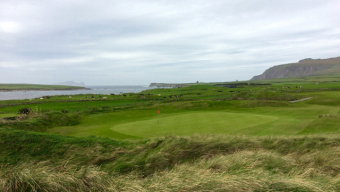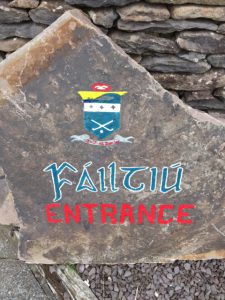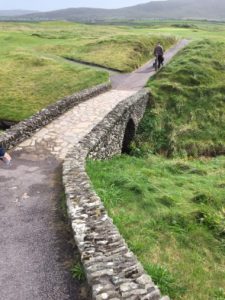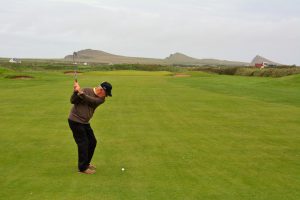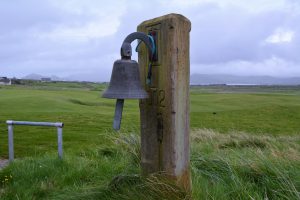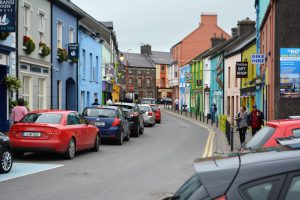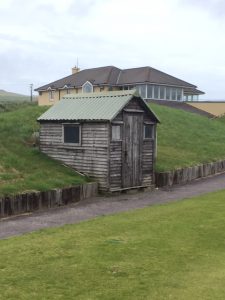Editor’s Note: During this difficult time dealing with the Coronavirus outbreak, leaving golf writers nothing to write about, we decided to revisit some of the places we have gone over the years. Today, we continue our 11-part Irish golf series at Dingle.
(Eighth of an 11-part series)
BALLYFERRITER, County Kerry, Ireland — Back in the late 1970s, when acclaimed Irish golf course designer Eddie Hackett added nine more holes to finish off Dingle Golf Links, all he might have needed was a shovel, a rake and a tee sheet.
Hackett got the credit, but nature did the work. It seems once the glaciers receded, all that was needed was a clubhouse and a starter.
Dingle is such a natural part of the landscape, with ribbons of green weaving through the low undulating dunes and meandering burn. Move a little dirt from there to here. Bunker over there, bunker right here. Set down the tee blocks and swing away.
Standing on the first tee with the whole course in view, you can see how the layout fits comfortably into the environment.
Located on the Dingle Peninsula, it is the most westerly course in Ireland. Nothing farther west from here to New York except the Blasket Island, vast amounts of saltwater and the Titanic remains.
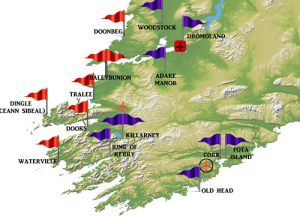 The course is on a gradual slope toward the sea. Farmlands and a gentle mountain range surround the property. Brandon Mountain, a walk-able 3,000-foot slope, is Ireland’s second highest peak. The evenly spaced Three Sisters peaks to the west can be used as targets for fairway approaches. It’s a panoramic wonder.
The course is on a gradual slope toward the sea. Farmlands and a gentle mountain range surround the property. Brandon Mountain, a walk-able 3,000-foot slope, is Ireland’s second highest peak. The evenly spaced Three Sisters peaks to the west can be used as targets for fairway approaches. It’s a panoramic wonder.
The locals here clearly love it but they call it by a different name. Its Gaelic name: Galf Chumann Ceann Sibeal.
That roughly means Sybil Head golf course, a nod to a nearby dramatic headland on the Dingle Peninsula, named after the wife of a swashbuckling 17th century poet Piaras Feiritéar, who was hanged in 1653.
Gaelic is spoken here (along with English), one of three regions in Ireland where the ancient language is taught in schools and written on signs. The course has signs in both languages.
While history in the distant past is reflected here, the future, sort of, is also part of the local lore. One of the mountain peaks overlooking the course was the location last year for a soon-to-be-released Star Wars movie, episode VIII.
An entire futuristic city was built on top as the crews were here for six months to film – when the stars showed up — for about two weeks. Some crew members spent their down times playing the course.
It is a links course but the dunes are of modest heights and it doesn’t actually touch the sea. But there is water, as the burn comes into play for 13 holes. That can be a problem for first-timers because the streams lay, unseen, a couple hundred yards off tee, only to be rudely discovered.
It has the feel of your neighborhood course back home – only tougher – because there is nothing to stop the wind off the Atlantic.
The par-5, 550-yard 6th hole, a straight-forward hole, feels like the essence of Dingle. You are among the dunes, seemingly in a sheltered, peaceful place with the Three Sisters peaks on the horizon.
After you make the turn around the clubhouse, perhaps a quick shot of Irish whiskey will prepare you from your next golf shot. On the par-3, 197-yard 10th, you are greeted with the hardest shot on the course. It’s long. It’s narrow with the wind in your face. Good luck trying to land and settle on a raised surface. You fall short left and the only way you’ll find your ball in the manic fescue is if you step on it.
The next hole, a par-5, 523 yarder, is just fun, one of the quirkiest holes on our visit to the Island. It zigs and zags with the burn running diagonally. A good drive can reach the stream. A good second shot down range also has a chance to get wet. You almost turn dizzy – in three different directions – to reach the green.
Coming home on the par-5, 504-yard 18th, bunkers on the right are inherently attracted to golf balls. Then you will have a blind shot over a dune to the slanted green. Solid finishing hole. It’s relatively short with the wind behind you so if you can avert all that trouble, you can set up a birdie putt for your departure.
Unlike many remote courses in Ireland where there is not much more than a convenience store in the area, backtracking to the town of Dingle is a delight. It’s a fairly large and robust village by the water with great shops, restaurants and traditional Irish music.
DINGLE GOLF CLUB (Local name: Ceann Sibeal)
Location: Ballyferriter, Dingle, County Kerry
Opened: 1924
Architects: Eddie Hackett, Christy O’Conner, Jr.
Type: Links
Tees: Blue (6,737), White (6,477), Red (5,227)
Par: 71
Green Fees: April-September: $60-85 (Euros); October-March: $30-55
Memorable Holes
No. 6: Par-5, 550 yards. Quite straight among dunes with magnet bunkers left; protected green.
No. 10: Par-3, 197 yards. Course’s hardest shot, long drive to elevated green with wind distraction.
No. 11: Par-5, 523 yards. Zig-zag quirky; diagonal creek vexes first and second shots.
No. 18: Par 5, 504 yards. Bunker problems both sides on drive and protected elevated green.
MONDAY: Dooks





